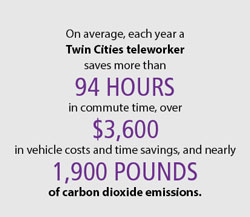Nearly a decade ago, Minnesota launched its eWorkPlace program to help employers and employees understand the benefits of telework, with the goal of reducing congestion and pollution and creating a happier workforce. U of M researchers recently completed the third phase of a project that monitored the program and analyzed its results—and found dramatic shifts in both the attitudes toward telework and its prevalence.
“Telework has become common—this is both great news and the biggest challenge we faced in this phase of our eWorkPlace project,” says Adeel Lari, research fellow with the Humphrey School of Public Affairs. “Because so many workers are already aware of telework as an alternative to commuting to an office and so many employers offer remote work, there is less demand for the external telework consulting services that eWorkPlace provides.”
Despite these trends, eWorkPlace made significant gains in the past two years. Most notably, eWorkPlace enjoyed success in promoting its services during the ongoing, multi-year downtown freeway reconstruction project and the Super Bowl in February 2018.
“Hundreds of new employees were recruited to telework in order to escape construction traffic, and hundreds more began teleworking in anticipation of the Super Bowl and then continued teleworking once the event was over,” Lari says. “These employees overwhelmingly reported significant improvements in productivity, work-life balance, and overall well-being.”
With the help of the eWorkPlace Commuter Savings Calculator tool, researchers were able to help quantify the benefits these employees—and hundreds of others like them—gained through telework. On average, each teleworker eliminated more than 94 commute hours, saved over $3,600, and reduced emissions by nearly 1,900 pounds of carbon dioxide each year.
The third phase of the eWorkPlace project ran from March 2017 through September 2018 and included a number of components, including productive local partnerships, a robust online presence, and a variety of promotional events. Notable program participants were the Minnesota Department of Transportation (MnDOT), the Minnesota Department of Education, 3M, Thrivent Financial, Allina Health, and Medtronic.
“In our transportation consulting work with downtown Minneapolis companies, we’ve found quite a bit of telework adoption, especially among tech-focused organizations that are used to using management and benchmarking software to guide projects,” says Mary Morse Marti, executive director of Move Minneapolis, a nonprofit program of the Minneapolis Regional Chamber that promotes sustainable commuting. “Really, that’s the key: teaching managers to manage outcomes rather than people. Once managers are skilled and comfortable managing deliverables, the where and when of how work gets done doesn’t matter nearly as much. We’d love to see more companies train their staff in these methods.”
A final takeaway researchers noted in this phase is that power in the workplace has shifted. “As telework has grown in popularity, employees are starting to enjoy greater autonomy in the workplace and have more control over their working conditions,” Lari says. “For eWorkPlace, this means shifting away from employer outreach efforts and instead working toward promoting eWorkPlace directly to employees.”
The project was sponsored by the Metropolitan Council and MnDOT. eWorkPlace is a state-sponsored initiative for Twin Cities-area businesses that fosters teleworking.





